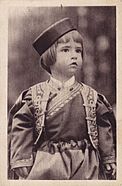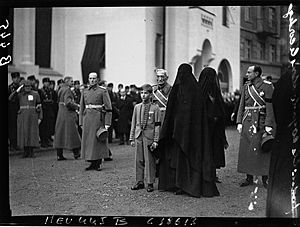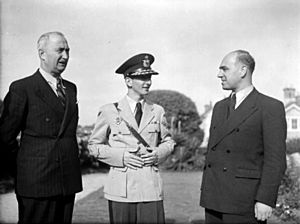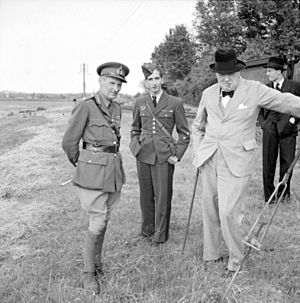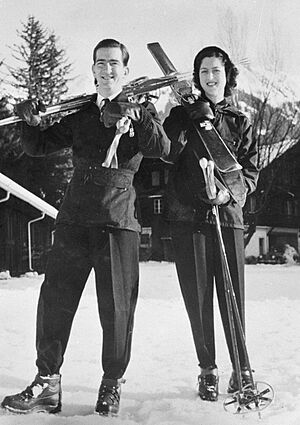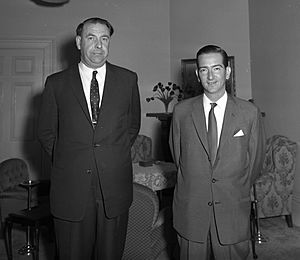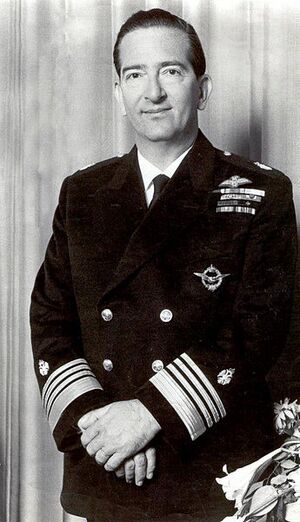Peter II of Yugoslavia facts for kids
Quick facts for kids Peter IIPetar II Karađorđević Петар II Карађорђевић |
|
|---|---|
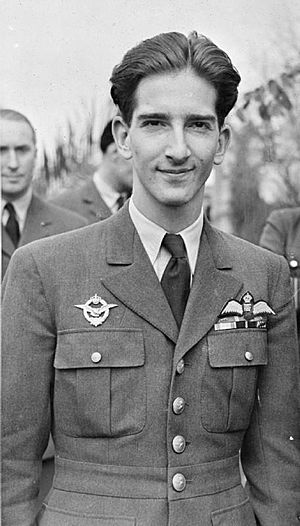
King Peter in January 1944
|
|
| King of Yugoslavia | |
| Reign | 9 October 1934 – 29 November 1945 |
| Coronation | 28 March 1941 |
| Predecessor | Alexander I |
| Successor | Monarchy abolished (Ivan Ribar as President of the Presidium of the People's Assembly of Yugoslavia) |
| Regent | Paul (1934–41) |
| Head of the Royal House Karađorđević | |
| Tenure | 29 November 1945 – 3 November 1970 |
| Successor | Alexander, Crown Prince of Yugoslavia |
| Born | 6 September 1923 Old Royal Palace, Belgrade, Kingdom of Serbs, Croats and Slovenes |
| Died | 3 November 1970 (aged 47) Denver, Colorado, U.S. |
| Burial |
|
| Spouse |
Alexandra of Greece and Denmark
(m. 1944) |
| Issue | Alexander, Crown Prince of Yugoslavia |
| House | Karađorđević |
| Father | Alexander I of Yugoslavia |
| Mother | Maria of Romania |
| Religion | Serbian Orthodox |
| Styles of Peter II of Yugoslavia |
|
|---|---|
 |
|
| Reference style | His Majesty |
| Spoken style | Your Majesty |
Peter II Karađorđević (Serbian Cyrillic: Петар II Карађорђевић, romanized: Petar II Karađorđević; 6 September 1923 – 3 November 1970) was the last king of Yugoslavia. He ruled from October 1934 until he was removed from power in November 1945. He was the last king from the Karađorđević dynasty.
Peter was the oldest child of King Alexander I and Maria of Romania. He became king of Yugoslavia in 1934 when he was only 11 years old. This happened after his father was assassinated during a trip to France. A group of people, called a regency, was set up to rule for him. This group was led by his cousin, Prince Paul.
In March 1941, Prince Paul decided that Yugoslavia would join the Tripartite Pact. This was an agreement between Germany, Italy, and Japan. Soon after, a coup d'état (a sudden takeover of the government) happened. This coup removed Prince Paul and declared Peter old enough to rule. However, Axis forces invaded Yugoslavia ten days later. This forced King Peter and his government to leave the country.
A government-in-exile was formed in June 1941 in London. In March 1944, Peter married Princess Alexandra of Greece and Denmark. Their only son, Alexander, was born a year later. In November 1945, the government in Yugoslavia officially removed Peter from power. They then declared Yugoslavia a republic, meaning it would no longer have a king.
After being removed from power, Peter moved to the United States. He passed away in November 1970 at the age of 47. His body was first buried in Illinois. Later, in 2013, his remains were moved to the Royal Mausoleum in Oplenac, Serbia.
Contents
Early Life of Peter II
Peter II was born on September 6, 1923, in Belgrade, Yugoslavia. He was the first son of Alexander I of Yugoslavia and Maria of Romania. His godparents included important royal figures like Queen Elizabeth of Greece and King George VI of the United Kingdom.
Young Prince Peter was first taught at the Royal Palace in Belgrade. Later, he went to Sandroyd School in England. When he was 11, Peter became king of Yugoslavia on October 9, 1934. This happened after his father was assassinated in France. Because Peter was so young, a regency council was formed to rule the country. His father's cousin, Prince Paul, led this council.
Prince Regent Paul wanted to keep the kingdom as King Alexander had left it. He planned for Peter to take full control when he turned 18 in September 1941. In 1939, Paul allowed an agreement to be signed that created a new, more independent region called the Banovina of Croatia. This region covered parts of what is now Bosnia and Herzegovina. This agreement aimed to solve problems with the Croats.
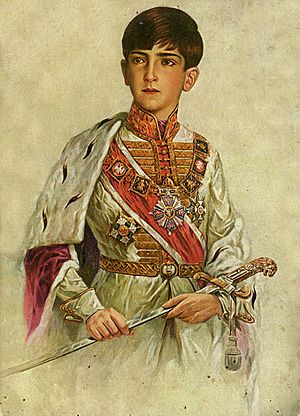
However, this agreement was not popular with the Serbs. Many Serbs felt that Peter, as King Alexander's son, would continue his father's policies of a strong central government. This disagreement was one reason for the coup d'état that happened in March 1941.
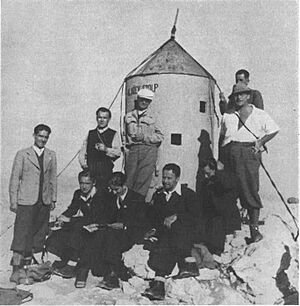
World War II and Exile
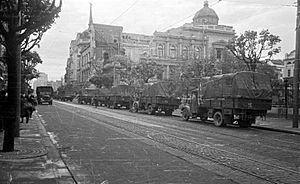
On March 25, 1941, Prince Regent Paul announced that Yugoslavia would join the Tripartite Pact. Just two days later, a pro-British coup d'état took place. King Peter, then 17 years old, was declared old enough to rule. General Dušan Simović led this takeover. Peter was very popular in Belgrade, and crowds cheered for him.
The new government, formed on March 27, 1941, included members from many political parties. However, Nazi Germany attacked Yugoslavia on April 6, 1941. German planes bombed Belgrade, killing thousands. Within a week, Germany, Bulgaria, Hungary, and Italy invaded Yugoslavia. The government was forced to surrender on April 17. Parts of Yugoslavia were taken over by these countries. The rest were controlled by German-backed governments.
King Peter and his government left Yugoslavia after the invasion. They traveled to Greece, then to Jerusalem and Cairo. In April 1941, Peter stated he would fight until victory. In May 1941, he confirmed an earlier agreement that aimed to make Yugoslavia a semi-federation after the war. Many of his original ministers did not go into exile, leaving the government-in-exile mostly Serb.
Government in Exile
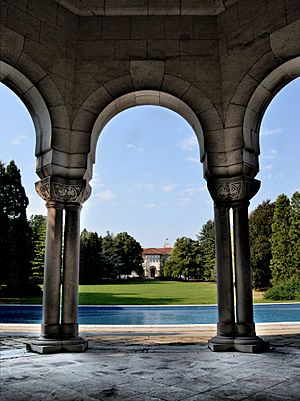
In June 1941, King Peter arrived in London. He joined other governments in exile from countries occupied by the Nazis. The British media saw Peter as a symbol of his country's fight for freedom. He was even featured as a hero in an American comic book.
Peter soon realized that the British paid more attention to governments that could help the Allied war effort. Yugoslavia had few soldiers who escaped to Egypt, so its government-in-exile had little to offer militarily. However, when reports came in that a guerrilla group called the Chetniks, led by Colonel Draža Mihailović, were fighting the Germans, Peter saw this as a way to help the Allies.
The Chetniks were most active in Serbia and Montenegro. Another group, the Communist Partisans, gained support from Serbs in Bosnia and from anti-fascist Croats, Slovenes, and Bosnian Muslims. The Partisans were better organized and fought more actively against the occupiers. This led Britain and the United States to eventually favor the Partisans.
Peter continued his education at Cambridge University and joined the Royal Air Force. In 1942, Peter dismissed his prime minister, General Simović. He then appointed Slobodan Jovanović as the new prime minister and Mihailović as minister of war. Peter also visited the United States and Canada, meeting President Franklin D. Roosevelt. He hoped to gain support for his cause.
During his visit to the United States, King Peter met the famous scientist Nikola Tesla in July 1942. Tesla told him: "I am glad you are in your youth, and I am content that you will be a great ruler. I believe I will live until you come back to free Yugoslavia."
Peter hoped that General Mihailović and the Chetniks would help him return to power. However, the Chetniks' strong Serb nationalist views offended other groups in Yugoslavia. Reports also emerged that some Chetnik commanders were working with the Axis forces against the Communist Partisans. This greatly damaged Peter's image in the West.
The government-in-exile tried to stop the civil war between the Partisans and Chetniks, but they had no control over either group. Peter's statements defending the Chetniks, even as evidence of their collaboration grew, hurt his reputation. Peter was seen as easily influenced by his ministers, which made his policies inconsistent.
Marriage and Later Life
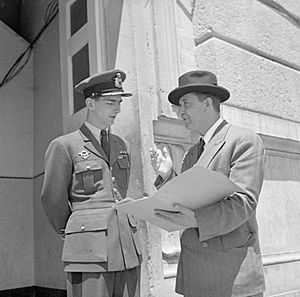
In July 1943, Peter announced his engagement to Princess Alexandra of Greece and Denmark. While the Western media called it a "fairy tale romance," the news caused problems in Yugoslavia. Serbian tradition said a leader should not marry during a national crisis. Yugoslavia was suffering greatly from war and civil conflict. Many people saw Peter's wedding in London as insensitive.
His government ministers also objected to the wedding during wartime. Peter married Alexandra in London on March 20, 1944. King George VI of Britain was his best man. Other European kings and queens also attended. Their son, Crown Prince Alexander, was born on July 17, 1945.
The news of his wartime marriage further hurt Peter's standing with his people. In May 1944, British Prime Minister Winston Churchill pressured Peter to appoint Ivan Šubašić as prime minister. Šubašić's job was to work with Marshal Josip Broz Tito's Partisans. On June 16, 1944, it was announced that the Partisans were the only recognized group representing the government-in-exile in Yugoslavia.
On September 12, 1944, King Peter spoke on the BBC. He asked all his people to support Tito.
Deposition and Exile
After the war, Peter was not allowed to return to Yugoslavia. Prime Minister Šubašić negotiated an agreement that Peter could not return until a public vote decided if Yugoslavia would be a republic or a monarchy. Peter was upset by this, especially since he was 21 and no longer needed a regent.
In March 1945, a regency council began to govern in Belgrade. The new government, called the Democratic Federation of Yugoslavia, was mostly controlled by Communists. Peter and Tito criticized each other. Peter accused Tito of creating a Communist dictatorship. In the elections for the new assembly in November 1945, there were reports of unfair voting.
Peter was officially removed from power by Yugoslavia's Communist Constituent Assembly on November 29, 1945. Yugoslavia was then declared a republic. After this, Peter settled in the United States. He visited Chicago in 1948 and spoke to various groups in the Midwest.
Peter continued to hope that he would one day return to the Yugoslav throne. He believed that groups loyal to him in Serbia would rise up to overthrow Marshal Tito. In the 1950s, Peter faced financial difficulties while living in France. In 1967, Peter took a job for the first time in his life, working for a savings and loan association in Los Angeles. He said this job helped his image as a king.
Final Years and Reburial
Peter passed away in Denver, Colorado, on November 3, 1970, at the age of 47. He was buried in the Saint Sava Monastery Church in Libertyville, Illinois. He was the only European monarch to be buried in the United States.
In the 1980s, a TV show called Dynasty became popular in Yugoslavia. One of its stars was related to the Karađorđević family. This led to a new interest in the royal family in Serbia. King Peter, whose death had gone largely unnoticed in his homeland, became more remembered.
On March 4, 2007, Peter's son, Crown Prince Alexander, announced plans to move his father's body back to Serbia. Peter had chosen to be buried in Illinois temporarily due to the situation in his homeland. In January 2013, the Serbian government confirmed the move. The new burial place would be the Royal Family Mausoleum in Oplenac.

On January 22, 2013, Peter's remains were returned to Belgrade. He was buried in the Royal Family Mausoleum at Oplenac on May 26, 2013. His wife, Queen Alexandra, was buried with him. His mother, Queen Maria, and brother, Prince Andrej, are buried nearby. The Serbian Royal Regalia (royal symbols) were placed on Peter's coffin. Important figures like the Prime Minister and the Serbian Patriarch attended the ceremony.
Honours
| Kingdom of Yugoslavia | |
| Order of Saint Prince Lazarus, Sovereign and Collar | |
| Order of Karađorđe's Star, Grand Master and Grand Cross | |
| Order of Karađorđe's Star with Swords, Grand Master | |
| Order of the White Eagle, Grand Master and Grand Cross | |
| Order of the White Eagle with Swords, Grand Master | |
| Order of the Yugoslav Crown, Grand Master and Grand Cross | |
| Order of Saint Sava, Grand Master and Grand Cross | |
| International and Foreign Awards | |
| Legion of Honour, Grand Cross (France) | |
| Order of the Redeemer, Grand Cross (Greece) | |
| Order of the Most Holy Annunciation, Collar (Italy) | |
| Order of Saints Maurice and Lazarus, Bailiff Grand Cross (Italy) | |
| Order of the Crown of Italy, Knight Grand Cross (Italy) | |
| Order of the White Lion, Collar (Czechoslovakia) | |
| Constantinian Order of Saint George, Bailiff Grand Cross (Two Sicilies) | |
| Order of Malta, Bailiff Grand Cross (SMOM) | |
| Order pro merito Melitensi, Collar (SMOM) | |
See also
 In Spanish: Pedro II de Yugoslavia para niños
In Spanish: Pedro II de Yugoslavia para niños



